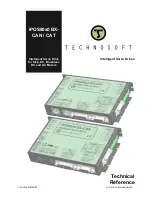
149
Appendix B: EMC Installation
Another source of the “black magic” reputation of electrical noise abatement comes
from the area of ca ble shielding.There are two objectives to cable shielding.The
first is to shield the signals in the cable from outside interference.Traditionally,
protecting sensitive,low voltage signals,such as encoder and resolver feedback
signals,from corruption has been the main focus of industrial cable shielding.
Preventing the high voltage,motor power signals from destroying the integrity of
these feedback signals is obviously a k ey part of a functional machine.
The second objective of shielding is to protect the outside environment from
unacceptable electromagnetic noise emissions. With the advent of formal
electromagnetic noise emission standards,this facet of shielding has become even
more important.The high frequency (30 MHz to 1 GHz) spectrum covered by these
regulations dictate using at least a quality, braided,shield on all cabling.The small
cracks and imperfections found in foil shields make them ineffective at these high
frequencies.Even low power cables must be properly protected with a braided
shield.These low voltage,signal or feedback wires often share a logic ground with
the microprocessor and clock of the control.The clock ground is a significant
contributor to the radiated noise in the frequency range in question.
Another way in which EMC shielding differs from traditional shielding is in the
connection of the shield to ground.A solid,360˚ connection to ground rather than
a single wire connection or even a braided strand connection can help prevent
radiated noise problems.Connecting the cable shield to ground at BOTH ends of
the shield can also help reduce the level of radiated noise.Please note there could
be safety problems with this practice if the two grounds are at different potential
levels. The shield could actually become a current carrying conductor. Safely
connecting shields should always take precedence over any potential radiated
emission reductions.
Grounding
Grounding is another topic that has a slightly different meaning in an EMC context
than it has had traditionally. Generally, local wiring safety codes thoroughly co ver
the subject of grounding,as it relates to personal safety, but they rarely address
proper high frequency grounding practices.A good safety or DC ground can be
made with a wire or small area contact.A high frequency ground connection
requires a broad contact region or a wide braided strap to be effective.Simple
wires can act like an open circuit at the radio frequencies under consideration. For
this reason when mounting component or chassis to a cabinet,it is important that
the paint on both surfaces be scraped away.A simple star washer grounding
scheme may not be effective.
As always,the relevant local safety standards supersede any EMC precautions.
Summary of Contents for B8961
Page 111: ...109 Chapter 7 Programming with Serial Communication...
Page 132: ...B8961 and B8962 User Manual 130...
Page 136: ...B8961 and B8962 User Manual 134 B8961 and B8962 Hardware Connections...
Page 137: ...135 Chapter 8 Hardware Reference B8961 and B8962 Input and Output Schematics...
Page 138: ...B8961 and B8962 User Manual 136 Connecting IDC Limit Switches to the B8961 2...
Page 156: ...B8961 and B8962 User Manual 154...








































